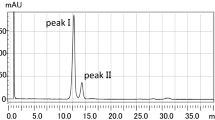Abstract
Polar lipids of bacteria from the class Thermomicrobia are known to contain long-chain 1,2-diols instead of glycerol, although the nature of polar head groups has not been investigated. We have studied phospholipid classes of two species from the class Thermomicrobia—Sphaerobacter thermophilus and Thermomicrobia sp. WKT50.2. TLC and 31P-NMR analysis of polar lipids revealed that both S. thermophilus and Thermomicrobia sp. WKT50.2 contain the same set of four major phospholipid classes. Structures of the novel phospholipids in S. thermophilus were established as 2-acylalkyldiol-1-O-phosphoinositol, 2-acylalkyldiol-1-O-phosphoinositol mannoside, 2-acylalkyldiol-1-O-phospho-acylmannoside, and 2-acylalkyldiol-1-O-phosphoinositol acylmannoside. To our knowledge, this is the first report of a phospholipid with a mannose directly bound to the phosphate. We also analyzed fatty acids and long-chain 1,2-diols of S. thermophilus and Thermomicrobia sp. WKT50.2 and compared our data with available information for T. roseum. All species share a similar set of fatty acids, with 12-Me 18:0 being the major fatty acid. The major diol in S. thermophilus was identified as 13-Me 19:0 (66.2 %). The 21:0 diol was the major component both in Thermomicrobia sp. WKT50.2 (50.6 %) and in T. roseum (56.6 %).




Similar content being viewed by others
Abbreviations
- diolPIns:
-
2-Acylalkyldiol-1-O-phosphoinositol
- diolPInsMan:
-
2-Acylalkyldiol-1-O-phosphoinositol mannoside
- diolP-acylMan:
-
2-Acylalkyldiol-1-O-phospho-acylmannoside
- diolPIns-acylMan:
-
2-Acylalkyldiol-1-O-phosphoinositol acylmannoside
- NMR:
-
Nuclear magnetic resonance
- TLC:
-
Thin-layer chromatography
- ESI:
-
Electrospray ionisation
- GCMS:
-
Gas chromatography–mass spectrometry
- MS:
-
Mass spectrometry
- HMBC:
-
Heteronuclear multiple bond coherence
- HSQC:
-
Heteronuclear single quantum coherence
- COSY:
-
Correlation spectroscopy
References
Ratledge C, Wilkinson SG (1988) Fatty acids, related and derived lipids. In: Ratledge C, Wilkinson SG (eds) Microbial Lipids, vol 1. Academic Press, USA
Batrakov SG, Panosyan AG, Konova IV, Bergelson LD (1974) Diol lipids: XXVI. Identification of a threo-butane-2,3-diol phospholipid from Actinomyces olivaceus. Biochim Biophys Acta, Lipids Lipid Metab 337:29–40
Van der Meer MT, Schouten S, Hanada S, Hopmans EC, Damsté JS, Ward DM (2002) Alkane-1,2-diol-based glycosides and fatty glycosides and wax esters in Roseiflexus castenholzii and hot spring microbial mats. Arch Microbiol 178:229–237
Wait R, Carreto L, Nobre MF, Ferreira AM, da Costa MS (1997) Characterization of novel long-chain 1,2-diols in Thermus species and demonstration that Thermus strains contain both glycerol-linked and diol-linked glycolipids. J Bacteriol 179:6154–6162
Yang Y-L, Yang F-L, Jao S-C, Chen M-Y, Tsay S-S, Zou W, Wu S-H (2006) Structural elucidation of phosphoglycolipids from strains of the bacterial thermophiles Thermus and Meiothermus. J Lipid Res 47:1823–1832
Pond JL, Langworthy TA, Holzer G (1986) Long-chain diols: a new class of membrane lipids from a thermophilic bacterium. Science 231:1134–1136
Pond JL, Langworthy TA (1987) Effect of growth temperature on the long-chain diols and fatty acids of Thermomicrobium roseum. J Bacteriol 169:1328–1330
da Costa MS, Albuquerque L, Nobre MF, Wait R (2011) The identification of polar lipids in prokaryotes. In: Rainey F, Oren A (eds) Methods in microbiology. Academic Press, USA
Sorokin DY, Vejmelkova D, Lücker S, Streshinskaya GM, Rijpstra WIC, Sinninghe Damsté JS, Kleerbezem R, van Loosdrecht M, Muyzer G, Daims H (2014) Nitrolancea hollandica gen. nov., sp. nov., a chemolithoautotrophic nitrite-oxidizing bacterium isolated from a bioreactor belonging to the phylum Chloroflexi. Int J Syst Evol Microbiol 64:1859–1865
Hugenholtz P, Stackebrandt E (2004) Reclassification of Sphaerobacter thermophilus from the subclass Sphaerobacteridae in the phylum Actinobacteria to the class Thermomicrobia (emended description) in the phylum Chloroflexi (emended description). Int J Syst Evol Microbiol 54:2049–2051
Stott MB, Crowe MA, Mountain BW, Smirnova AV, Hou S, Alam M, Dunfield PF (2008) Isolation of novel bacteria, including a candidate division, from geothermal soils in New Zealand. Environ Microbiol 10:2030–2041
Jackson TJ, Ramaley RF, Meinschein WG (1973) Thermomicrobium, a new genus of extremely thermophilic bacteria. Int J Syst Bacteriol 23:28–36
Bligh EG, Dyer WJ (1959) A rapid method of total lipid extraction and purification. Can J Biochem Physiol 37:911–917
MacKenzie A, Vyssotski M, Nekrasov E (2009) Quantitative analysis of dairy phospholipids by 31P NMR. J Am Oil Chem Soc 86:757–763
Vaskovsky VE, Kostetsky EY, Vasendin IM (1975) A universal reagent for phospholipid analysis. J Chromatogr A 114:129–141
Carreau JP, Dubacq JP (1978) Adaptation of a macro-scale method to the micro-scale for fatty acid methyl transesterification of biological lipid extracts. J Chromatogr A 151:384–390
Morrison WR, Hay JD (1970) Polar lipids in bovine milk II. Long-chain bases, normal and 2-hydroxy fatty acids, and isomeric cis and trans monoenoic fatty acids in the sphingolipids. Biochim Biophys Acta, Lipids Lipid Metab 202:460–467
Vyssotski M, Ryan J, Lagutin K, Wong H, Morgan X, Stott M (2012) A novel fatty acid, 12, 17-dimethyloctadecanoic acid, from the extremophile Thermogemmatispora sp. (strain T81). Lipids 6:601–611
Clarke NG, Dawson RM (1981) Alkaline O→N-transacylation. A new method for the quantitative deacylation of phospholipids. Biochem J 195:301–306
Renkonen O (1965) Individual molecular species of different phospholipid classes. Part II. A method of analysis. J Am Oil Chem Soc 42:298–304
Wait R, Carreto L, Nobre MF, Ferreira AM, da Costa MS (1997) Characterization of novel long-chain 1,2-diols in Thermus species and demonstration that Thermus strains contain both glycerol-linked and diol-linked glycolipids. J Bacteriol 179:6154–6162
Hsu F-F, Turk J (2009) Electrospray ionization with low-energy collisionally activated dissociation tandem mass spectrometry of glycerophospholipids: mechanisms of fragmentation and structural characterization. J Chromatogr B 877:2673–2695
Hsu F-F, Turk J, Owens RM, Rhoades ER, Russel DG (2007) Structural characterization of phosphatidyl-myo-inositol mannosides from Mycobacterium bovis Bacillus Calmette Gúerin by multiple-stage quadrupole ion-trap mass spectrometry with electrospray ionization. II. Monoacyl- and diacyl-PIMs. J Am Soc Mass Spectrom 18:479–492
Nagatsuka Y, Horibata Y, Yamazaki Y, Kinoshita M, Shinoda Y, Hashikawa T, Koshino H, Nakamura T, Hirabayashi Y (2006) Phosphatidylglucoside exists as a single molecular species with saturated fatty acyl chains in developing astroglial membranes. Biochemistry 45:8742–8750
Kaneda T (1991) Iso- and anteiso-fatty acids in bacteria: biosynthesis, function, and taxonomic significance. Microbiol Rev 55:288–302
Yabe S, Aiba Y, Sakai Y, Hazaka M, Yokota A (2011) Thermogemmatispora onikobensis gen. nov., sp. nov. and Thermogemmatispora foliorum sp. nov., isolated from fallen leaves on geothermal soils, and description of Thermogemmatisporaceae fam. nov. and Thermogemmatisporales ord. nov. within the class Ktedonobacteria. Int J Syst Evol Microbiol 61:903–910
Short SA, White DC (1970) Metabolism of the glycosyl diglycerides and phosphatidylglucose of Staphylococcus aureus. J Bacteriol 104:126–132
Morita YS, Patterson JH, Billman-Jacobe H, McConville MJ (2004) Biosynthesis of mycobacterial phosphatidylinositol mannosides. Biochem J 378:589–597
Acknowledgments
This work was supported by Callaghan Innovation, Capability Fund project “Bioactives from New Zealand extremophiles” and the GNS Science Geothermal Resources of New Zealand (GRN) programme. We are grateful to Dr. Herbert Wong for NMR spectra recording and Dr. Yinrong Lu for MS recording (both from Callaghan Innovation).
Author information
Authors and Affiliations
Corresponding author
Electronic supplementary material
Below is the link to the electronic supplementary material.
About this article
Cite this article
Lagutin, K., MacKenzie, A., Houghton, K.M. et al. Novel Long-Chain Diol Phospholipids from Some Bacteria Belonging to the Class Thermomicrobia . Lipids 50, 303–311 (2015). https://doi.org/10.1007/s11745-014-3979-3
Received:
Accepted:
Published:
Issue Date:
DOI: https://doi.org/10.1007/s11745-014-3979-3




